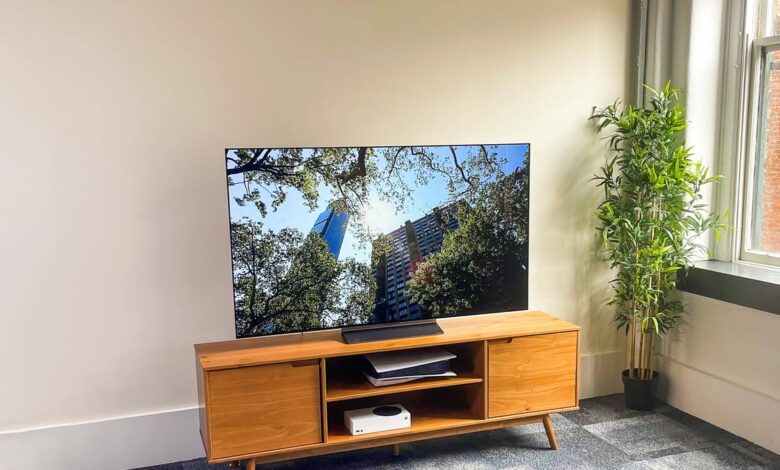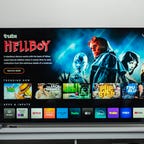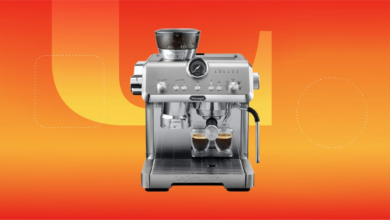Best TV for PS5 and Xbox Series X, Series S for 2024: LG OLED, Hisense, Vizio


A TV can be used for more than just for watching movies or TV shows. The use cases of TVs have changed over the years, and most people purchasing a new TV these days will have several other factors to consider, including whether the new TV will be compatible with their gaming setup. These TVs usually boast several great gaming features, such as HDMI 2.1’s 120Hz and low-latency support. Any TV with an HDMI cable will be compatible with a PS5, Xbox Series X and Xbox Series S console, but it won’t be able to take advantage of the full potential of any of these modern consoles.
The best 4K TVs these days are equipped with HDMI 2.1 ports, which have the power to let you play at 4K with HDR and reach frame rates as high as 120 frames per second. On top of all that, the gameplay stays butter-smooth, with the consoles and TV playing nice via variable refresh rate, which reduces choppy movement and screen tearing for solid picture quality.
The good news is that you don’t have to spend a fortune on an 88-inch 8K behemoth to get these gaming console-friendly features. In fact, you can find most of the features necessary for an excellent gaming experience, including 4K 120Hz and VRR, in 50-inch TVs at $600 or less and 65-inch models for less than $1,000.
What is the best TV for PS5 and Xbox right now?
LG’s C3 may be on the expensive side, but it pairs high-end image quality with impressive gaming features on every input. All of the TV’s HDMI ports include the latest version of the HDMI standard: 2.1. That means its HDMI ports can handle 4K at 120 frames per second and variable refresh rate (including Nvidia G-Sync and AMD FreeSync), as well as enhanced audio return channel and automatic low latency mode (auto game mode). In other words, it can take advantage of the latest graphics features available from PlayStation 5 and Xbox Series X and S consoles as well as high-end graphics cards. The C3 is somewhat rare among high-end TVs in that all four of its HDMI ports support 4K/120 — great for hard-core gamers with multiple next-gen devices. The TV also comes with a specialized Game Optimizer settings suite. It’s a great choice for gamers who want an excellent picture and aren’t afraid to splurge to get it.
Best TVs for PS5 and Xbox of 2024
Whether you’re looking for the best TV for PS5 gaming, Xbox Series X or S, or another next-gen console, here are our current favorite gaming TV options. Unless otherwise noted all of the prices listed are for 65-inch sizes, but every series is available in other sizes too.
LG’s C3 offers some of the best TV image quality we’ve tested, comes in a variety of sizes and includes the full range of gaming features on every input. The C3 represents the pinnacle of picture quality, at a price that’s admittedly high, but not too crazy. It beats any non-OLED TV on this list, including the Samsung QN90B below, with its perfect black levels, unbeatable contrast and superb off-angle viewing. It also has excellent gaming features, making it a great companion to an Xbox Series X or S, PlayStation 5 or both. The C3 comes in a variety of sizes as well, though the bigger models are expensive.
The C3 is also one of the lightest TVs we’ve ever reviewed thanks to carbon-fiber construction. The 65-inch version weighs about 41 pounds with its stand, which is slightly heavier than last year’s 65-inch C2 at 37 pounds with its stand.
In our tests over the years, Vizio TVs have produced very good picture quality without breaking the bank. The Vizio Quantum Pro continues this trend and holds up as a solid midpriced TV option, with a few notable drawbacks.
In side-by-side comparison tests in our lab, the Quantum Pro performed well for the money, with better contrast than the similarly priced Roku Plus Series, for example. On the other hand, as expected, slightly more expensive models like the TCL QM8 and Hisense U8K were better, with brighter images and higher contrast.
One major drawback is the Quantum Pro’s lack of size offerings; it comes only in 65- or 75-inch sizes. We reviewed the 65-inch model, but the review also applies to the 75-inch version since the specs and picture quality should be similar regardless of size.
The Quantum Pro can handle 4K 120Hz sources, which allows for smoother images while gaming, but it’s via only one of its four HDMI inputs. That’s enough for most people, but if you have both an Xbox Series X and PlayStation 5, you’ll have to connect one to a less-capable input and lose the benefits of that smoothness.
Our favorite TV overall for the money happens to be an excellent gaming TV as well. TCL has improved some of its gaming features, though the QM8’s level of extras isn’t quite as comprehensive as what you find with Samsung or LG. In the settings menu (Settings > system) there’s something called Game Master that turns on VRR and Auto Low Lag Mode and allows access to a game bar and three different gaming specific picture modes. The game bar (accessible by holding down the three-line menu button under the Home key on the remote) shows current gaming status, including real-time frames per second, HDR and other features, and allows you to switch between the three modes.
This TV has an excellent image thanks to mini-LED tech and well-implemented full-array local dimming that helps it run circles around just about any other TV at this price. As expected, the TCL checked all the boxes on my Xbox Series X’s compatibility menu, including Dolby Vision for gaming. Input lag in HDR was excellent, at 13.9 milliseconds (for some reason my devices didn’t register in SDR, so I couldn’t test lag there).
Comparing the game mode image quality between the Hisense, TCL and LG C3, the story was similar to what I saw with TV and movies. The C3 looked the best overall when I played Starfield, and the TCL had the brightness advantage, but the image of the Hisense looked a bit more balanced to my eye, with more natural color, than did the TCL’s. Overall, however, I preferred the more dynamic picture of the TCL over the Hisense for games in my side-by-side comparison.
Our favorite TV overall for the money happens to be an excellent gaming TV as well. TCL has improved some of its gaming features, though the QM8’s level of extras isn’t quite as comprehensive as what you find with Samsung or LG. In the settings menu (Settings > system) there’s something called Game Master that turns on VRR and Auto Low Lag Mode and allows access to a game bar and three different gaming specific picture modes. The game bar (accessible by holding down the three-line menu button under the Home key on the remote) shows current gaming status, including real-time frames per second, HDR and other features, and allows you to switch between the three modes.
This TV has an excellent image thanks to mini-LED tech and well-implemented full-array local dimming that helps it run circles around just about any other TV at this price. As expected, the TCL checked all the boxes on my Xbox Series X’s compatibility menu, including Dolby Vision for gaming. Input lag in HDR was excellent, at 13.9 milliseconds (for some reason my devices didn’t register in SDR, so I couldn’t test lag there).
Comparing the game mode image quality between the Hisense, TCL and LG C3, the story was similar to what I saw with TV and movies. The C3 looked the best overall when I played Starfield, and the TCL had the brightness advantage, but the image of the Hisense looked a bit more balanced to my eye, with more natural color, than did the TCL’s. Overall, however, I preferred the more dynamic picture of the TCL over the Hisense for games in my side-by-side comparison.
In our review of the Hisense we rated its overall image quality nearly as good as the TCL, and we actually liked its gaming picture a bit better, thanks to punchier highlights. Its input lag also scored well in our lab.
Its excellent image quality is anchored by best-in-class brightness that improves its bright-room picture quality and makes HDR TV movies, shows and games really pop. It’s actually brighter than the TCL with better contrast, but the TCL’s slightly more accurate image gave it the edge overall. The Hisense also uses Google TV instead of Roku. Frankly, you can’t go wrong with either one.
The U8K series looked largely similar to last year’s U8H aside from the addition of a 75-inch option in the newer series.
With all of the TVs available today, and all of the technical terms and jargon associated with television technology, it can be tough to figure out what’s important. Here’s a quick guide to help cut through the confusion.
Price: TVs range in price from $100 to more than $2,000. Smaller screens are cheaper, well-known brands are more expensive and spending more money can also get you better image quality. Most entry-level TVs have a good enough picture for most people, but TVs last a long time, so it might be worth spending more to get a better picture. It’s also best to shop for a TV in the fall, when prices are lower.
Screen size: Bigger is better in our book. We recommend a size of at least 43 inches for a bedroom TV and at least 55 inches for a living room or main TV — and 65 inches or larger is best. More than any other “feature,” stepping up in TV screen size is the best use of your money. One of the most common post-TV-purchase complaints we’ve heard is from people who didn’t go big enough. And we almost never hear people complain that their TV is too large.
Capability: Among entry-level TVs the most important feature is what kind of smart TV system the TV uses. Among midrange models, look for a feature including full-array local dimming, mini-LED and 120Hz refresh rate, which (unlike some other extras) do help improve the picture in our experience. And among high-end TVs, OLED technology is your best bet.
Our TV reviews follow a rigorous, unbiased evaluation process honed over nearly two decades of TV reviews. Our primary TV test lab has specialized equipment for measuring light and color, including a Konica Minolta CS-2000 spectroradiometer, a Murideo Sig-G 4K HDR signal generator and an AVPro Connect 8×8 4K HDR distribution matrix. We use Portrait Displays CalMan Ultimate software to evaluate every TV we review. In every CNET TV review, three or more similar TVs are compared side by side in various lighting conditions playing different media, including movies, TV shows and games, across a variety of test categories, from color to video processing to gaming to HDR. Our reviews also account for design, features, smart TV performance, HDMI input and gaming compatibility, as well as other factors.
One important aspect of image quality we test is overall brightness. Here’s how it compares in nits across select TVs listed above.
Check out How We Test TVs for more details.
For more TV buying advice check out How to Buy a TV.
What TVs support HDMI 2.1 features?





